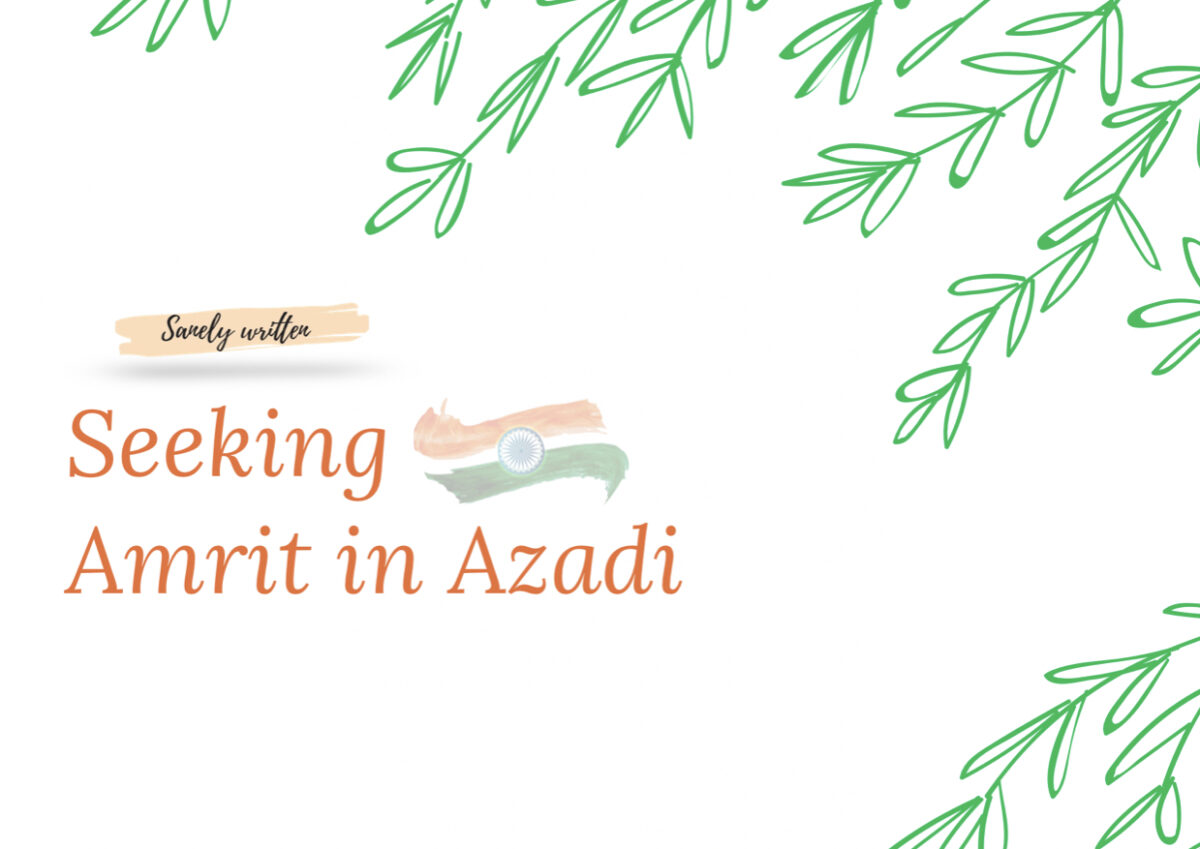At the stroke of midnight on 15th August 2022, Bharat has completed 75 years of independence. While the nation is in a festive mood celebrating the Amrit Mahotsav, it can also be a good time for us citizens to reflect on a few things. Even if we don’t notice it sharply, we are living in strange times, the age of cheap internet. And what comes along with it? The accessibility to the world of absurdity, where sisters half-truth and no-truth are carefully catered to the users because the contents that are able to draw a clear line between ‘us’ and ‘them’ are the contents promoted by the algorithms of social media as they top all the charts of engagement metric. But this world serves one more purpose; to subtly and most of the time blatantly convert masses into potential vote banks by pitting one against another. While these dystopian sentences about our beloved Bharat seem to be overwhelmingly heavy with our little pride silently whispering to us that ‘No, you are not the multitude’, we think your conscience will be the best judge of it.
The seemingly woke beginning might have given an impression to some of our readers that maybe it is just another piece on how the pluralism of this country is affected by this atmosphere of hate. Well, we have cleared our take on pluralism in our previous pieces, this one is about a different issue. It is about the paradox of tolerance.
Unlimited tolerance must lead to the disappearance of tolerance. If we extend unlimited tolerance even to those who are intolerant, if we are not prepared to defend a tolerant society against the onslaught of the intolerant, then the tolerant will be destroyed, and tolerance with them. We should therefore claim, in the name of tolerance, the right not to tolerate the intolerant.
Karl R. Popper, The Open Society and Its Enemies – Volume One: The Spell of Plato
India has been plundered, invaded, colonised, ethnically and culturally cleansed more than any nation on the face of the earth. Restoration is inevitable and in the current times, with the current regime, we are more hopeful than ever. But regimes and their nationalist propaganda cannot single-handedly shield us from the voice of those worms who will sit crossed-leg on a modern chair, ergonomically designed to support their spine (or the lack of it), asking questions, “What has happened to our country that was once for all?” And they will reach you. Because the shield is not invincible and their swords of fancy words are good at breaking shields.
As blasphemous as it might seem, we are not practicing our dharma (not religion) well. But the woke said that Hindu culture had its flaws. Is it too rigid to be applied to modern progressive society? Maybe. Is it castist and patriarchic? Maybe. Is it supportive of women’s oppression? Maybe. Does it teach eternal tolerance? NO. If the examples of our heroes Rama and Krishna are too mythological to be true, here is a prose by Atal Bihar Vajpayee Ji, one of the fewest people of Indian history that everyone will agree to be a ‘moderate’ Hindu.
मैं शंकर का वह क्रोधानल कर सकता जगती क्षार-क्षार। डमरू की वह प्रलय-ध्वनि हूं जिसमें नचता भीषण संहार। रणचण्डी की अतृप्त प्यास, मैं दुर्गा का उन्मत्त हास। मैं यम की प्रलयंकर पुकार, जलते मरघट का धुआंधारय। फिर अन्तरतम की ज्वाला से, जगती में आग लगा दूं मैं। यदि धधक उठे जल, थल, अम्बर, जड़, चेतन तो कैसा विस्मय? हिन्दू तन-मन, हिन्दू जीवन, रग-रग हिन्दू मेरा परिचय! …… मैं वीर पुत्र, मेरी जननी के जगती में जौहर अपार। अकबर के पुत्रों से पूछो, क्या याद उन्हें मीना बाजार? क्या याद उन्हें चित्तौड़ दुर्ग में जलने वाला आग प्रखर? जब हाय सहस्रों माताएं, तिल-तिल जलकर हो गईं अमर। वह बुझने वाली आग नहीं, रग-रग में उसे समाए हूं। यदि कभी अचानक फूट पड़े विप्लव लेकर तो क्या विस्मय? हिन्दू तन-मन, हिन्दू जीवन, रग-रग हिन्दू मेरा परिचय! होकर स्वतंत्र मैंने कब चाहा है कर लूं जग को गुलाम? मैंने तो सदा सिखाया करना अपने मन को गुलाम। गोपाल-राम के नामों पर कब मैंने अत्याचार किए? कब दुनिया को हिन्दू करने घर-घर में नरसंहार किए? कब बतलाए काबुल में जा कर कितनी मस्जिद तोड़ीं? भूभाग नहीं, शत-शत मानव के हृदय जीतने का निश्चय। हिन्दू तन-मन, हिन्दू जीवन, रग-रग हिन्दू मेरा परिचय! - अटल बिहारी वाजपेयी
So is this a clarion call to stop being tolerant? No. It is just a reminder that in the pursuit of a tolerant society, being indifferent will be a disservice to our great nation. Bharat needs us to be actively intolerant towards all those who are perpetrating their agenda to break us. And the restoration work, though important, will be of little help. Because at some point in time, we will have to acknowledge that the scars of our invaders are irreversible. The fabric of India has been soaked in blood and rewoven by the winners of the plunderage. And it’s not very hard to accept. In fact, we have already accepted and got used to it. That is why the Sanskrit in ‘Amrit’ is linked with the Persian in ‘Azadi’ in a sentence structured in English, the language of our former colonisers and yet it sounds familiar.
This is about doing our part in mending and upgrading our shield, this is about taking it to the streets when we see elected leaders bowing down to protect their seats, this is about educating ourselves with the help of the internet to form correct opinions, this is all about criticising the man sitting on the seat while giving our utmost respect to the seat. So, yes this Amrit will also demand a manthan because our Azadi is not limited to a date when some white people left this nation. Our Azadi has to be without any constraints. Our Azadi has to be aligned with our culture. Our Azadi has to be eternal. And it’s up to us.




3 replies on “Seeking Amrit in Azadi”
Very nice 👍👍
Thought provoking article 🙌🏻
Equal Education policy needed for India:
If English medium education is better in India then why not translate all English curriculum and Sanskrit literature in regional languages and provide equal education/information to all? Don’t people read PM’s Mann kī Bāt in all regional languages on websites? Don’t they teach the Bible in all Indian languages? Sanskrit scholars provide Vedic knowledge to westerners in English via translation and transliteration but not the same way to fellow Indians who protect languages and culture in Indic scripts.Gujarat has given great political leaders as well as simple script to the nation and yet Hindi is taught in a complex printing ink wasting script despite it’s simplification into Gujanāgari script.
If pundits were happy with the complex printing ink-wasting Devanagari script they may not have created various scripts under different rulers for vernacular languages to divide the country. Nowadays Devanagari Lipi Parishad prefers a single Devanagari script despite it’s simplification into Gujanāgarī script for all Indian languages to slowly eliminate vernacular scripts the way they did with Maharashtra’s MODI script.
Westerners learn Sanskrit in English via translation and transliteration and challenge Indians but Indians are not allowed to learn Sanskrit the same way in vernacular languages.Why not make the same efforts in teaching mother language as you do for Sanskrit? How is modern Sanskrit going to be better than Vedic Sanskrit in providing knowledge? Does the government spend an equal amount of money on the promotion of all state languages?
India needs to create more jobs for Indic translators to provide equal education and information to all in Indic languages.
Also India has more English speakers than Great Britain and yet Indian English doesn’t have itś own Indian English dictionary with pronunciation key to challenge IPA with highly phonetic Indic alphabets. http://sanskrit-ai.com/threads/mappings-for-devan%C4%81gar%C4%AB-indic-roman%C4%81gar%C4%AB.333/
Since Sanskrit has complex grammar and lengthy sandhi words in sentences it may not be good for effective speech, for rhyming poetic words as well as for voice to text typing, dictation and effective translation without lengthy interpretation.
If India’s four percent of pundits can earn livelihood by praising Sanskrit, performing rituals and reading Satyanarayan Katha to villagers, why should they learn Sanskrit the hard way ? Sanskrit is taught in schools and colleges and used in Vedic rituals but how many of these people are fluent in Sanskrit?
NCERT prefers to provide education in Hindi and Urdu but not in regional languages. Why? If Hindi can be written in Urdu script then why not in regional scripts the way Sanskrit can be written?
Newly added Sanskrit on Google Translate could pose a challenge to Indian pundits who traditionally impart Vedic knowledge to Westerners through translation and transliteration tools but not to fellow Indians who defend scripts and culture in local languages.